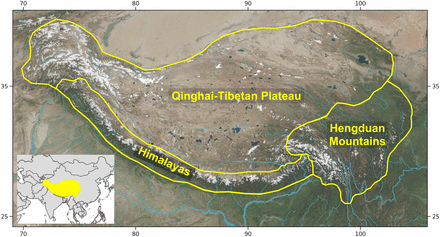The Hengduan Mountains is very rich in plant diversity, with a vascular flora of about 12,000 species in an area of about 500,000 km2. It is a biodiversity hotspot uplifted over the last 8 million years. However, it remains unclear how and why resident species accumulated. Of primary interest is tempo (the rate of accumulation) and mode (the process, whether by colonization via dispersal or in situ lineage diversification).
Prof. XING Yaowu of Xishuangbanna Tropical Botanical Garden (XTBG) and Prof. Richard H. Ree of The Field Museum, Chicago conducted a study to see how and why the tempo and mode varied in time and space. They aimed to better understand the origins of this remarkable flora through the lens of historical biogeography. They particularly wanted to test whether in situ diversification was accelerated by uplift of the Hengduan Mountains.
The researchers used the evolutionary histories of multiple plant groups to study the floristic assembly of the Hengduan Mountains region, focusing on comparisons to adjacent regions, especially the Himalayas and other geologically older parts of the Qinghai–Tibetan Plateau (QTP).
They used data from 19 clades of vascular plants chosen for their potential to inform the biogeographic history of the Hengduan Mountains. They inferred regional rates of diversification and colonization through time from fossil-calibrated molecular chronograms and reconstructions of ancestral range and rates of lineage diversification.
Their phylogenetic inferences showed that after about 8 million years the rate of in situ diversification increased in the Hengduan Mountains, yielding a remarkable inflection point at which cumulative speciation overtakes colonization.
The result indicated that the Hengduan Mountains flora has been assembled disproportionately by recent in situ diversification that coincides temporally with independent estimates of orogeny.
The study showed quantitative evidence for uplift-driven diversification in the Hengduan Mountains. It tested the uplift-driven diversification hypothesis that orogeny creates conditions favoring rapid in situ speciation of resident lineages.
The study entitled “Uplift-driven diversification in the Hengduan Mountains, a temperate biodiversity hotspot” has been published online in Proceedings of the National Academy of Sciences of the United States of America (PNAS).
Contact
XING Yaowu Ph.D Principal Investigator
Key Laboratory of Tropical Forest Ecology, Xishuangbanna Tropical Botanical Garden, Chinese Academy of Sciences, Mengla, Yunnan 666303, China
E-mail: ywxing@xtbg.org.cn

Map of the Hengduan Mountains region in relation to theQinghai–Tibetan Plateau and Himalayas.
(Image by XING Yaowu)

The Hengduan Mountains. (Image from Baidu)


